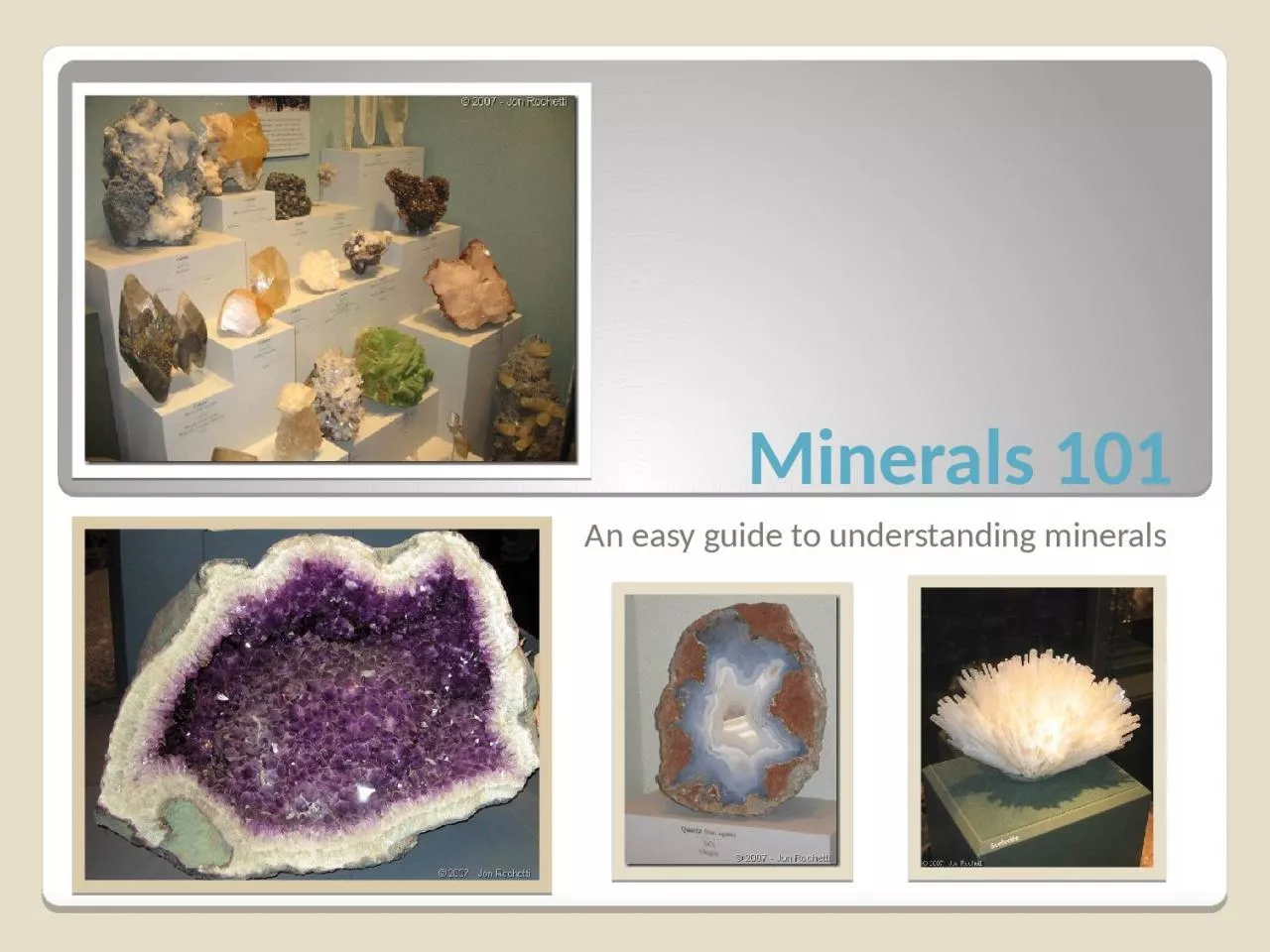

Background Information The Earths crust is made of mostly rocks and soil The rocks are made of different combinations of minerals Minerals are made of elements Remember an element ID: 1030349
Download Presentation The PPT/PDF document "Minerals 101 An easy guide to understand..." is the property of its rightful owner. Permission is granted to download and print the materials on this web site for personal, non-commercial use only, and to display it on your personal computer provided you do not modify the materials and that you retain all copyright notices contained in the materials. By downloading content from our website, you accept the terms of this agreement.
1. Minerals 101An easy guide to understanding minerals
2. Background Information!The Earth’s crust is made of mostly rocks and soil.The rocks are made of different combinations of minerals.Minerals are made of elements. (Remember an element is any substance that cannot be broken down into simpler substances. The smallest unit of an element is an atom.) There are over 100 chemical elements, which are the building blocks of all matter in the universe.Atoms may be bonded together into molecules; when two or more kinds of atoms bind together chemically, a compound is formed.
3. What is a mineral?A mineral is a naturally occurring, inorganic, solid which possesses a characteristic internal atomic structure and a definite chemical composition.
4. PropertiesSolidNot a liquid or a gasNaturally Occurring Found in nature, not man made InorganicNot living, not formed by living processesFixed CompositionHas a chemical formula, most are formed from compounds of two or more elements, some minerals consist of one element ex. Au (Gold)Crystal FormA structure where atoms are in an orderly and repeated pattern.
5. Identification5 steps for mineral identification. Determine:LusterHardnessColor (Light or Dark)Cleavage? Streak?After your choices have been narrowed down, use the mineral identification chart!
6. LusterLuster refers to how light is reflected from the surface of a mineral. Classified as Metallic or Nonmetallic?If metallic, skip color (light or dark) step. MetallicNon-Metallic
7. HardnessThe hardness of a mineral is its ability to resist scratching.Where did the hardness scale originate?Friedrich Mohs, a German mineralogist, developed a hardness scale over 100 years ago. The hardest mineral known, diamond, was assigned the number 10.The Mohs Hardness Scale ranks the order of hardness of minerals and some common objects. For example, your fingernail can scratch the minerals talc and gypsum, with a hardness of 2 or lower. A copper penny can scratch calcite, gypsum, and talc. Fun Fact!: The hardness of a mineral is known as its “scratchability!”
8. Color Minerals are colored because certain wavelengths of light are absorbed, and the color results from a combination of those wave lengths that reach the eye.The color of a mineral is the first thing most people notice. But it can also be the least useful in identifying a mineral. Most minerals occur in more than one color. Fluorite can be clear, white, yellow, blue, purple, or green. The other properties, such as hardness, cleavage, and luster, must be used instead. Both samples in the picture are the mineral fluorite, note that color is different but the crystal shape is the same.
9. CleavageCleavage is the ability of a mineral to break along preferred planes. Planes of weakness exist in some minerals because of their atomic structure. Atomic bonds may be weaker in some directions than in others, so the mineral will tend to break, or cleave, in that direction.Minerals may have cleavage in only one direction, in only two directions, or in three or more directions. The cleavage angles at which these planes intersect may be distinctive. Minerals that have "perfect" cleavage almost always break in a preferred direction. Minerals that have "good" cleavage sometimes will break in a particular direction, and other times they may not. Fun Fact!: Gemstones are “cut” along cleavage planes!
10. StreakThe streak of a mineral is the color of the powder left on a streak plate (piece of unglazed porcelain) when the mineral is scraped across it. The streak plate has a hardness of glass, so minerals with a Mohs Hardness >7 will scratch the streak plate and won't powder the mineral. Streak can be useful for identifying metallic and earthy minerals. Nonmetallic minerals usually give a white streak because they are very light-colored. Other minerals may have very distinctive streaks; hematite, for example, always gives a reddish brown streak no matter what type of luster it displays.
11. Test Yourself!As a class categorize the next few slides as “Minerals” or “Non-minerals”. Remember a mineral is: SolidNaturally Occurring InorganicFixed CompositionCrystal Form
12. Fossil
13. GOLD
14. WOOD
15. Diamond
16. Pearls
17. Quartz
18. Bone
19. Amethyst
20. Results - MineralsGoldDiamond QuartzAmethystNon-mineralsFossilWoodPearlsBone